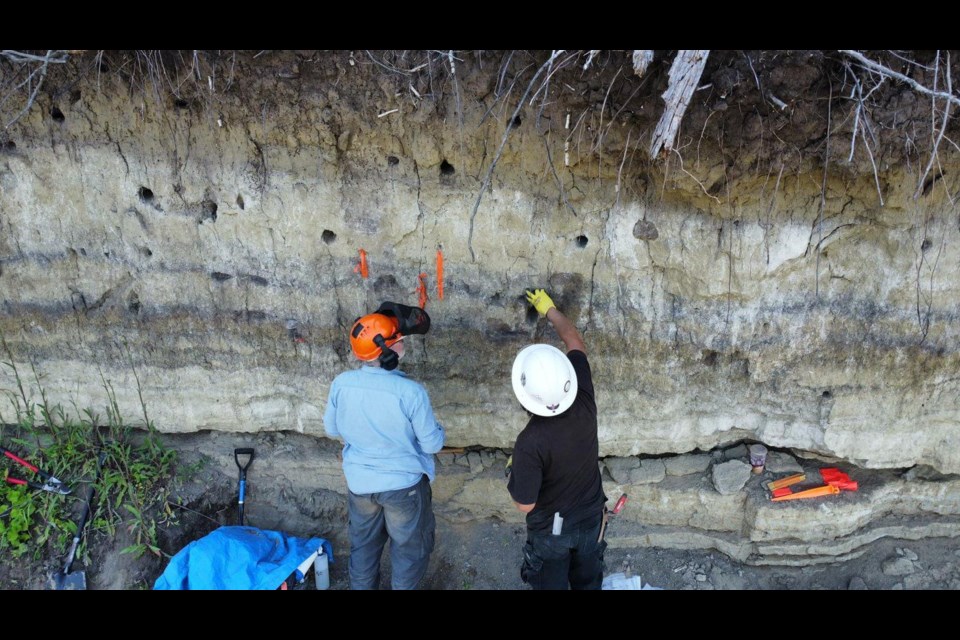PRINCE ALBERT. — Dave Rondeau, a Métis community-based researcher from Crutwell, Sask., made a shocking discovery in the spring of 2023.
A massive ice break in the North Saskatchewan River carved out the side of a hill near the river, exposing a face or profile of that hill containing thousands of years of history.
“For that cut-back to reveal itself and give up its secrets, that’s an absolute gift,” said Rondeau. “And that gift needs to be shared so everyone can benefit from it,”
Those secrets are beginning to reveal themselves, said Rondeau.
The layers in the hill reveal when the last Ice Age ended, followed by plant growth and evidence of human settlement – with flakes of stones left over from stone making, large campfires or ceremonial fires, and animal remains.
A bone sample sent away for radiocarbon dating came back as 9,200 years old. By comparison, Wanuskewin Heritage Park dates back around 6,700 years.“It’s extremely old for our area because it's understood that this area was underwater or still under ice around that time,” said Rondeau. “So, it was impossibly old for our area. But you can’t really go by one sample.”
Rondeau said other experts have said the site could be the oldest settlement in the region.
Sites with this level of preservation are rare, said Andrea Freeman, an associate professor and department head of Geography at the University of Calgary (U of C).
“We know if people are using this site at that time, they’re coming in pretty quickly after the glaciers have left, and the landscape is changing quite dramatically,” she said. “So, for me, it's been the black swan I’ve been looking for, for the last 15-20 years.”
Only one artifact has been carbon-dated and the age of the bone may be off a couple hundred years, but regardless, the site is very old, said Freeman.
“The really important thing about this site is that it’s buried – in a context that is preserved,” she said. “A lot of times when we find these sites, we find them on the surface…it's been preserved for thousands of years, if and when we excavate it, we’ll get a snapshot of that time period.”
One of the early discoveries is evidence of a ‘hearth’, a large area usually kept for heating or cooking.
There is also a large layer of charcoal – evidence people were burning off old growth to entice new animals to come in.
“It just shows that First Nations land stewardship goes back 10,000 years,” said Rondeau. “And none of this is new. I don’t feel that this is a ‘discovery’. Oral history and traditional knowledge speaks of this land stewardship, we’re just verifying it.”
Researchers might also gain insights into how our ancestors dealt with climate change.
Freeman said about 8,500-9,000 years ago, as the glaciers were retreating, global temperatures increased by about 1.5 to 2 degrees, which lasted for several thousand years. Currently, we are again experiencing a global rise in temperatures at an alarming rate, causing extreme weather events.
“When we look at how Indigenous people, who were the ancestors of the people living in these areas today, responded to that drastic climate change occurring all over the high plains, we can get a better sense of how we can be responsive to those conditions and how we can protect ourselves,” she said.
Nicko Linares, a U of C graduate student, is studying and analyzing samples from the site, for his thesis which will be the first official published academic work on the site.
“We can look at the shapes of the plant fossils and begin to understand the vegetation that would have been there, and understand the climate and its changes,” he said. “Through this and a few other metrics, we’re basically rebuilding the landscape of the past 10,000 years.”
Linares is looking forward to the next steps of his research.
“My hope is to involve Indigenous youth in the project and help them connect to the past. And through connecting with Indigenous communities, use traditional knowledge and converge it with scientific discourse.”
Rondeau said all the work will be done in accordance with First Nations protocols and consultation. He believes in the future the site could hold an interpretation centre that would store the found artifacts on site – a place everyone from youth to archaeologists can come to learn about the past.
“I’m not looking for any lucrative benefit in any shape or form, that’s not what I’m about. It will benefit the community first,” he said. “It belongs to everyone. We’ll be stewards of this site.




